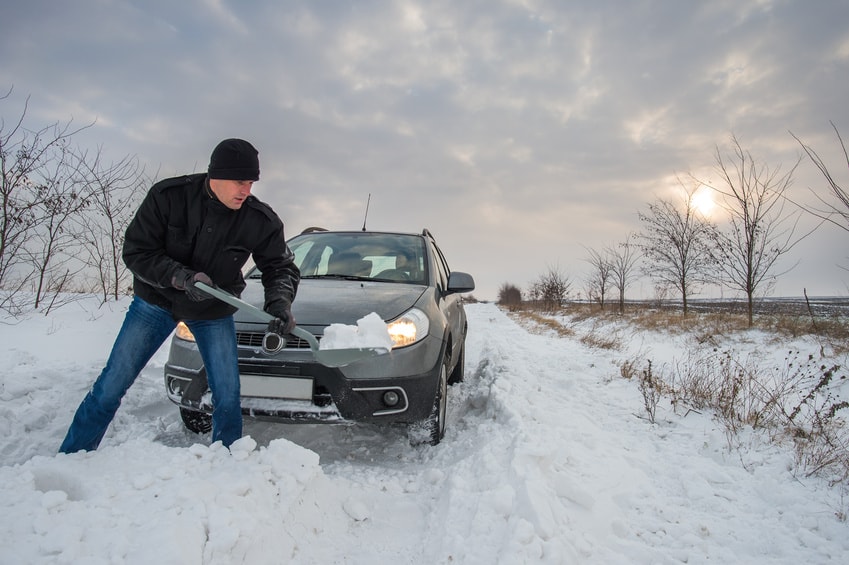How To Survive Being Trapped In Your Car During A Snowstorm
The best defense for any emergency is to be prepared. Would you know what to do? We have the answers.

In contemplating a family vacation, the lure of the land can draw us into extended road trips, maybe with a side foray here and there to investigate something of particular interest – just a little out of the way.
But sometimes even a “little” out of the way can lead to vastly unfamiliar territory. This is especially true in colder months when the landscape changes under the cover of snow – and summer’s popularly-travelled country roads begin to resemble little more than rural ghost trails.
For safety purposes, always file a “flight” plan with close friends or relatives: where you are starting out and where you are going; your anticipated route; what time you plan to arrive and what time they can expect you to check in with them. This small action each day can provide an enormous safety net if you end up stranded and unable to communicate.
With flat tires, an empty gas tank, broken axles (watch those boulders!), sudden snowstorms, snowdrifts, and debris on sparsely-traveled roads, the AAA and Federal Highway Administration say the best defense against unanticipated car camping is to be prepared for all contingencies. Many off-road areas have limited cell phone signals or none at all, so relying entirely on technology to get you help may not work. In fact, putting together a winter travel preparedness kit for your trunk can offer some degree of comfort while waiting for assistance, and even mean the difference between life and death. These ideas can help.
- If you’re stuck in the snow and the shovel you’ve packed in your kit isn’t doing the trick, a bag of kitty litter or the floor mats of your car, placed just in front or in back of your tires, may provide enough traction for you to power your vehicle out of a drift or rut.
- If there’s a snowstorm around you, under no circumstances should you leave your car as chances are you will quickly develop frostbite and hypothermia, and can succumb to exposure. Experts say it’s better to wait it out, and even afterwards, stay with the vehicle. If you are certain you passed civilization within a reasonable distance behind you (remember though: hiking in feet of snow can cost you days), and want additional insulation, slice up your car seat cushions to make strips of insulation to wrap around your feet and lower legs, and maybe your hands. A knife and duct tape should be part of your travel preparedness kit. (Survival pundits say if you don’t have a knife, find something like a rock to break your mirrors and carefully use the glass to cut the seats. Windows are made from tempered safety glass and will not shatter in a manner to produce shards that would work.)
- Next, believe it or not, experts recommend carrying tea lights (or larger candles in containers) and matches or cigarette lighters in your kit (enclose in a plastic bag to keep dry). Lighting just one candle on your dashboard can supply an unexpected amount of heat. Just be sure to close the vents and crack open a window. A small bottle of lantern fuel can help start a campfire. And a sturdy flashlight is also a good idea.
- If you have some gas left and want to use the heat, run the engine for up to 10 minutes every hour – being absolutely sure to crack open a window: deadly carbon monoxide can build up around you in a vehicle’s interior. Be sure, also, to clear snow from the tailpipe for the same reason as frequently as you need to, especially if it continues to snow.
- Flares in a plastic bag (to keep dry) are mandatory for auto trips, as is something that will allow you to project your voice like a standard megaphone or bull horn, or an air horn that’s generally used on boats – anything that will allow sound to travel a great distance – especially if you have decided to leave your car. Honking your car horn every few minutes can also be a good practice.
- Thermal sleeping bags or at the very least heavy blankets are necessities for road trips. Huddling together will provide additional body heat. Large trash bags also retain heat.
- Always bring along a couple of gallons of water. If you haven’t, or they run out and you need to eat snow, hold it in your mouth to warm it to prevent adding a further chill to your body. High calorie foods such as nuts (great for protein), granola bars, and dried fruit are important. If your pet is traveling with you, pet food is essential. And as the interior of a car turns into a freezer in cold temperatures, don’t forget to keep your pet wrapped up and warm. A rub down will serve to warm him and your hands. Huddle together to stay warm.
- Be sure to bury any human or pet waste deep in the snow so as not to attract animals.
- Tie a brightly-colored scarf or other piece of clothing to the car’s antenna to make it easier to spot from the air.
- Finally, though burning tires release toxic pollutants that may especially affect children, nursing babies, pregnant women, and the elderly, in a life-saving act it will serve to keep you warm and the thick black smoke may attract the attention of rescuers. And if you do get a fire of any kind going, tires or otherwise, and can safely place football-size rocks into it (don’t select rocks from near a water source as they may explode), allow to “bake” for an hour, remove using a stick, and place inside vehicle. The warmth they give off can last for hours.
Beth Herman
Beth Herman is a freelance writer with interests in healthy living and food, family, animal welfare, architecture and design, religion, and yoga. She writes for a variety of national and regional publications, institutions, and websites.






Why not pack a pair of over sized longjohns to pull over your legs and an extra pair with the seat cut out so that you can put your arms through another pair? That way longjohns can add some warmth to all extremities besides having a blanket or sleeping bag. also what about keeping a couple of those hang up anywhere (large size) Led lights that have sticky stuff to adhere to surfaces (in case of being stranded at night). Be sure that you have working batterres though. The lights might lead someone going by to offer assistance.
if you go out of you car for any reason, make sure not to get locked out. Especially important if you are stranded alone or with a small child. It may be helpful to stash an extra door key in a holder under a fender- just in case.
I’ve heard that if you get an unused paint can and fill it part way with sand and then you can set a good sized candle in the middle and it will safely burn for a long time and the heat will radiate out into the car. You can pack other things around it like snacks, etc, put the lid on and it will take up very little space in your car. Very handy idea.
I agree stay with your vehicle, you will be out of the weather and many areas have snowplows running daily or maybe a wrecker from a nearby town. Stay calm, keep warm, the candle idea is great as it afford heat, keep on all your clothes and sleep together with a child, toddler and baby between the adults and possibly next to the body to give them the heat from the larger body. No strenuous exercise to cause sweat within the layers of clothing. Small shovels and other tools are a help but depend on outside help for at least a day or more, then if necessary WHEN the weather clears and warms up the adult in best shape can possibly walk out to the nearest town or a farm house.
DON’T PANIC. Anil